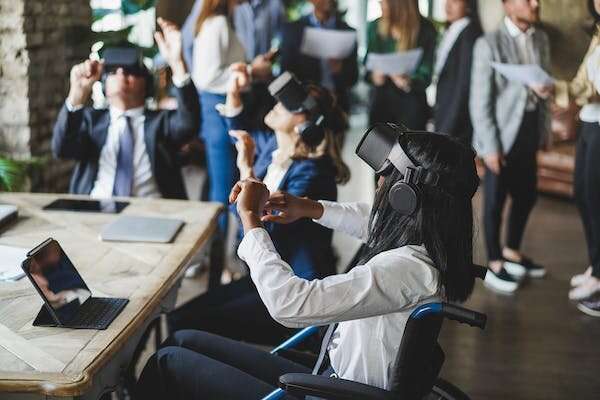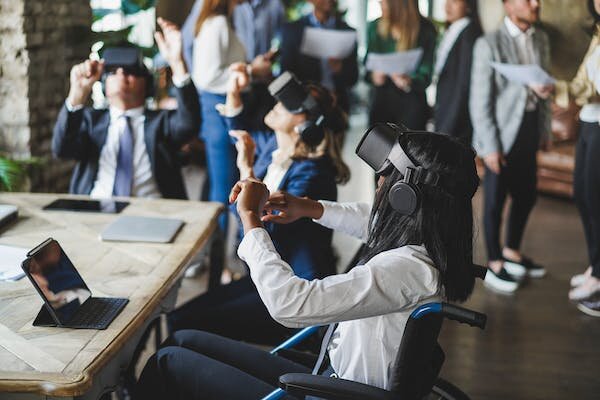
The invention of the world wide web in 1989 eventually brought about life-changing tools for everyone who can access it. Some of these tools, such as online banking, shopping and communication, have vastly improved the accessibility of daily life for people with disabilities, as well as older people.
The concept of virtual mobility has long been used to describe how the internet can provide an accessible alternative to activities that usually require physical mobility. Virtual mobility was in full swing during the pandemic, as work, entertainment and socializing efficiently moved online. The metaverse—the next phase of the internet powered by virtual and augmented reality (VR and AR)—has the potential to take things even further.
Working with Meta, the Royal National Institute of Blind People and other inclusive design-focused partners, our team of researchers will be investigating the potential of the metaverse to introduce life-changing benefits for disabled and older people, as well as developing solutions to improve its accessibility and inclusivity in our new project Towards an Equitable Social VR. Here are five areas where the metaverse could take virtual mobility to the next level.
1. Social life
The benefits of conventional social media for disabled people have been long established. Designed well, social spaces in the metaverse will advance these benefits through social virtual reality, which mimics in-person interaction, and permit people to interact freely without the obstacles that exist in the physical world.
Importantly, users in metaverse platforms like Meta’s Horizon Worlds will be able to represent themselves using virtual avatars. Research suggests that virtual avatars are a means through which some disabled people reflect aspects of their disability as a central part of their identity.
Others may self-represent through avatars that are totally imagined. The metaverse gives users freedom and creativity in terms of how they want to be seen and eliminates preconceptions that disabled and older people might face when interacting with others in person.
2. Education
The metaverse can potentially improve the range and quality of education delivery pathways available to disabled users, as well as late-life learning. Immersive technologies mean that higher education could be delivered in an engaging way, without requiring physical attendance.
This mode of delivery would eliminate some of the factors that exclude many people from accessing quality education, such as needing to move away from home or travel to a physical campus. There are also numerous opportunities to use the metaverse for remote coaching, personal development and skills training.
3. Work
The pandemic has shown how quickly we can adjust to new ways of working. A considerable number of people expect to work in the metaverse one way or another. A recent survey by Microsoft found that only 16% of the 31,102 survey participants, across generations, did not see themselves carrying out at least some of their job duties as “metawork” in the near future.
The metaverse can provide access to the types of work that one’s disability or age might otherwise make it difficult for them to access in the physical world. There is a growing community of designers getting ready to create the virtual interiors that will exist only within the metaverse. Other areas with interesting metaverse-based job prospects are digital fashion, real estate and, of course, building the Metaverse itself.
4. Entertainment and leisure
The pandemic brought music to the digital world in new ways, with artists from Travis Scott to Ariana Grande performing in virtual spaces.
Gigs in the metaverse are just one entertainment option—virtual cinemas, theater performances and museum and gallery exhibitions are all taking place already. Tourism is another arena where the Metaverse can provide opportunities to travel through digital environments. Tourists could also explore remote physical locations from the comfort of home through a virtual reality headset, making travel more accessible and affordable.
5. Healthcare and well-being
The metaverse can also become a powerful platform in the medical world, useful in different fields of medicine. As an example, extended reality (XR) simulation can be used for various types of medical education and training, such as emergency response and mental health. VR and AR can also enhance medical imaging in radiology and support diagnostics, treatment planning and medical research.
Another area of medicine where the metaverse has potential is telemedicine. VR can be used to facilitate remote consultation, especially where the medical personnel are not geographically available, like in many rural regions.
It is worth noting that the metaverse is not meant to replace the life and experiences in the physical world, but offer new options. However, for its potential to come to fruition, the metaverse must be built to be accessible, inclusive and equitable across the spectrum of ability and age.
This applies not just to the functional aspects (how easy it is to use the technology), but also to the social elements (how one can self-represent their disability and age). Other challenges with privacy, security, safety, communication and ethical behavior are also likely to emerge.


